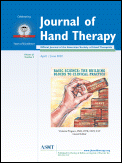
Journal of Hand Therapy
Scope & Guideline
Transforming patient care with evidence-based practices.
Introduction
Aims and Scopes
- Rehabilitation Techniques and Protocols:
The journal emphasizes evidence-based rehabilitation techniques, including various therapeutic approaches such as Kinesio taping, exercise programs, and the use of orthoses. - Clinical Assessment and Measurement Tools:
A significant focus on developing and validating clinical assessment tools for measuring hand function, grip strength, and other relevant outcomes in therapeutic settings. - Innovative Therapies and Technologies:
Exploration of new technologies and methodologies in hand therapy, including the use of telehealth, robotics, and 3D-printed solutions for orthopedic conditions. - Patient-Centered Care and Outcomes:
Research that prioritizes patient experiences, satisfaction, and outcomes, emphasizing the importance of patient-reported measures in evaluating therapy effectiveness. - Multidisciplinary Approaches:
Encouragement of multidisciplinary research involving hand therapists, surgeons, and other healthcare professionals to enhance treatment methodologies and patient care.
Trending and Emerging
- Telehealth and Remote Rehabilitation:
An increasing number of studies focus on the effectiveness and feasibility of telehealth and remote rehabilitation strategies, especially in light of the recent global shift towards digital healthcare. - Proprioception and Sensory Integration:
Research on proprioception, sensory feedback, and their roles in rehabilitation has become more prominent, highlighting the importance of these factors in recovery from hand injuries. - Patient-Reported Outcomes and Satisfaction:
There is a growing emphasis on understanding patient-reported outcomes, satisfaction, and engagement in the therapeutic process, pointing to a more patient-centered approach in research. - Innovative Orthotic Solutions:
A trend towards exploring novel orthotic designs, including relative motion orthoses and 3D-printed devices, signifies a shift towards personalized and adaptive treatment options. - Multifactorial Approaches to Injury Prevention:
Emerging studies are increasingly addressing the multifactorial nature of upper extremity injuries, including ergonomic considerations and psychosocial factors, underscoring a holistic approach to prevention.
Declining or Waning
- Surgical Techniques and Interventions:
There has been a noticeable decline in articles specifically addressing surgical techniques for hand conditions, suggesting a shift towards non-operative management and rehabilitation. - Traditional Orthotic Designs:
Research on conventional orthotic designs has decreased, possibly due to the emerging interest in innovative and customized orthotic solutions, such as 3D printing. - Generalized Pain Management Strategies:
Articles focusing on broad pain management strategies without specific application to hand therapy are less frequent, indicating a shift towards targeted interventions. - Historical Perspectives and Reviews:
The journal has seen fewer articles that provide historical overviews or general reviews of hand therapy practices, reflecting a trend towards more current and evidence-based research.
Similar Journals

Current Physical Medicine and Rehabilitation Reports
Shaping Tomorrow’s Practices in Rehabilitation MedicineCurrent Physical Medicine and Rehabilitation Reports, published by SpringerNature, is an esteemed academic journal dedicated to advancing the fields of physical medicine and rehabilitation. With a focus on disseminating high-quality research and evidence-based practices, this journal covers a broad spectrum of topics including orthopedic medicine, sports therapy, and comprehensive rehabilitation strategies. While it currently holds a Q3 quartile ranking across several related categories, including medicine and rehabilitation, the journal aims to elevate its impact through open access to its content, fostering a global discussion amongst researchers, professionals, and students alike. Navigating the intersections of innovation and clinical application, Current Physical Medicine and Rehabilitation Reports serves as a vital resource for those seeking to enhance their understanding and practice in this dynamic field. With its evolving scope, the journal is committed to publishing studies and reviews that shape the future of rehabilitation and physical medicine practices.
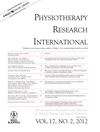
Physiotherapy Research International
Innovating Physiotherapy for Better Patient Outcomes.Physiotherapy Research International is a leading journal in the fields of Physical Therapy, Sports Therapy, and Rehabilitation, published by WILEY. With a commendable impact factor reflecting its significant contribution to the profession, this journal enjoys a competitive position, ranking in the 66th percentile and 84th out of 247 in its category according to Scopus. The journal encompasses a broad scope of research from 1996 to 2024, addressing critical advancements in physiotherapy and rehabilitation practices. Although it is not an Open Access journal, it provides valuable insights and research findings that foster knowledge and innovation among practitioners and researchers alike. As a Q2 category journal in its field for 2023, Physiotherapy Research International aims to facilitate the dissemination of high-quality research aimed at improving patient outcomes and guiding clinical practice. It serves as an essential resource for those committed to advancing the science and practice of physiotherapy.

Journal of Pediatric Rehabilitation Medicine
Innovating Rehabilitation: A Journal Committed to Pediatric ProgressJournal of Pediatric Rehabilitation Medicine is a leading academic platform published by IOS PRESS, dedicated to advancing knowledge in the fields of pediatrics, rehabilitation, and physical therapy. With an ISSN of 1874-5393 and an E-ISSN of 1875-8894, this journal has carved a niche within the biomedical community, focusing on therapeutic innovations and evidence-based practices in pediatric rehabilitation. Recognized for its scholarly contributions, it holds a prestigious Q3 ranking in Pediatrics and Q2 rankings in both Physical Therapy and Rehabilitation categories, indicating its impact and relevance in the respective fields. Operating out of the Netherlands, the journal provides a comprehensive open access model that ensures that research is easily accessible to professionals, students, and researchers alike. With converged years spanning from 2007 to 2024, the journal continues to be an essential resource for those dedicated to enhancing the quality of life for children with disabilities and rehabilitation needs, fostering collaboration between clinicians and researchers through high-quality research dissemination.

International Journal of Physiotherapy
Enhancing Lives: Comprehensive Research for Physiotherapy ExcellenceThe International Journal of Physiotherapy, published by IJPHY Publishers, is a distinguished platform committed to advancing the field of rehabilitation sciences and physiotherapy. With an ISSN of 2349-5987 and E-ISSN of 2348-8336, this Open Access journal has been facilitating global knowledge sharing since 2014. Located in the culturally rich city of Tirupati, Andhra Pradesh, India, the journal aims to provide comprehensive research findings, innovative therapeutic techniques, and insightful reviews in physiotherapy, thus catering to academics, clinicians, and researchers alike. By allowing unrestricted access to its content, the journal promotes the dissemination of evidence-based practices, thereby enhancing the quality of care and fostering professional development in the field. With a growing repository of scholarly articles and a commitment to maintaining high publication standards, the International Journal of Physiotherapy is poised to become an essential resource for anyone dedicated to the pursuit of knowledge in physiotherapy and rehabilitation.
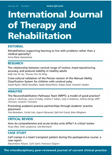
International Journal of Therapy and Rehabilitation
Advancing the Future of Therapy and RehabilitationInternational Journal of Therapy and Rehabilitation (ISSN: 1741-1645; E-ISSN: 1759-779X), published by MA HEALTHCARE LTD, is a premier platform for disseminating innovative research and clinical practices in the fields of physical therapy, sports therapy, and rehabilitation. As an influential contributor to the academic discourse in rehabilitation, this journal holds a notable impact factor and is recognized in the Q4 category in Physical Therapy, Sports Therapy and Rehabilitation and Q3 in Rehabilitation as of 2023. With rankings of #112 out of 161 and #190 out of 247 in Scopus, respectively, it remains committed to publishing high-quality research that addresses both the fundamental and contemporary challenges in therapy and rehabilitation. While the journal does not offer open access, it strives to present content that is highly relevant and impactful for practitioners, researchers, and students in the healthcare community. The journal's scope, spanning from 1996 to 2024, reflects its dedication to reflecting the evolving nature of therapy and rehabilitation practices globally.
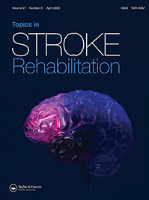
Topics in Stroke Rehabilitation
Enhancing lives with cutting-edge insights.Topics in Stroke Rehabilitation, published by Taylor & Francis Ltd, stands as a premier academic journal offering cutting-edge research and insights in the fields of rehabilitation, neurology, and community care. With an impressive impact factor reflecting its strong scholarly influence, this journal not only maintains a distinguished Q1 ranking in Community and Home Care and Rehabilitation but is also recognized in the Q2 category for Clinical Neurology, showcasing its relevance across multiple disciplines. Covering a comprehensive range of topics from neurorehabilitation techniques to patient-centered care strategies, Topics in Stroke Rehabilitation serves as an essential resource for researchers, healthcare professionals, and students dedicated to enhancing the quality of life for individuals recovering from stroke. With an accessible archive dating back to 1996 and continuous publication through 2024, this journal invites collaboration and discourse, fostering advancements in both theoretical knowledge and practical applications within the realm of stroke rehabilitation.

Physiotherapy
Fostering Excellence in Physiotherapy ScholarshipPhysiotherapy, published by Elsevier Science Ltd, stands as a prestigious journal in the field of Physical Therapy, Sports Therapy, and Rehabilitation. Since its inception in 1945, this journal has been committed to advancing the practice and science of physiotherapy through rigorous peer-reviewed research, making significant contributions to both clinical practice and academia. With an impressive Q1 ranking and a Scopus percentile of 88th, it is widely regarded as a leading source of evidence-based information for professionals and researchers alike. The journal operates without an Open Access option, which ensures that it maintains the quality and integrity of the research it publishes while providing exclusive access to valuable insights for its subscribers. By focusing on diverse topics within its scope, including therapeutic techniques, rehabilitation strategies, and sports medicine, Physiotherapy continues to shape the future of physiotherapy practice and education, making it an essential resource for anyone invested in this dynamic field.
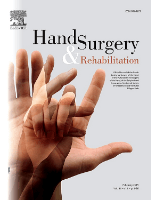
Hand Surgery & Rehabilitation
Advancing the Future of Hand CareHand Surgery & Rehabilitation, published by ELSEVIER, is a vital resource for researchers, clinicians, and students engaged in the fields of orthopedics, rehabilitation, and surgery. With an ISSN of 2468-1229 and an E-ISSN of 2468-1210, this journal has established a prominent presence since its inception in 2016, with a convergence period extending until 2024. It holds a commendable ranking in the Q2 category within Rehabilitation and Surgery, as well as a Q3 classification in Orthopedics and Sports Medicine for the year 2023. With a Scopus Rank of #290/551 in Surgery and #86/161 in Rehabilitation, it exemplifies the ongoing pursuit of excellence in its domain. As an open access journal, it provides a platform for sharing significant research findings and advancements in hand surgery and rehabilitation, thereby contributing to the enhancement of clinical practice and patient outcomes. Engaging with this journal places professionals at the forefront of the latest developments in these critical areas of medicine, promoting interdisciplinary collaboration and fostering innovation.
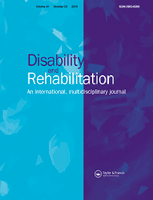
DISABILITY AND REHABILITATION
Elevating Standards in Disability Research and Practice.Disability and Rehabilitation, a prestigious journal published by Taylor & Francis Ltd, plays a critical role in the field of rehabilitation science. Since its inception in 1978, this journal has been dedicated to presenting high-quality research focused on improving the lives of individuals with disabilities through innovative rehabilitation techniques and healthcare solutions. With an impressive Q1 ranking in the Rehabilitation category and a Scopus rank of #24 out of 161, the journal is recognized for its significant impact and rigorous scholarly contributions, boasting an 85th percentile performance among peers. Although it operates under a subscription model, the journal remains a vital resource for researchers, healthcare professionals, and students seeking the latest insights and developments in the realm of disability and rehabilitation. Covering a broad spectrum of topics, from clinical practices to theoretical advancements, Disability and Rehabilitation continues to shape the future of rehabilitation research and practice worldwide.
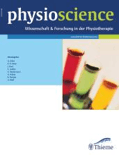
Physioscience
Connecting researchers and clinicians for impactful practices.Physioscience is a premier academic journal dedicated to the evolving field of physiotherapy and rehabilitation sciences, published by the esteemed GEORG THIEME VERLAG KG. The journal serves as a crucial platform for researchers, clinicians, and practitioners to disseminate cutting-edge research, innovative practices, and comprehensive reviews aimed at enhancing patient care and advancing the knowledge base in physical therapy. Although Physioscience does not operate under an open access model, it ensures wide visibility and accessibility of scholarly articles through esteemed databases. Its rigorous peer-review process guarantees the highest quality of published content, thereby maintaining its reputation as a leading resource for both fundamental research and clinical applications in physiotherapy. Positioned significantly in the health sciences field, Physioscience strives to foster interdisciplinary collaboration and stimulate ongoing dialogue among healthcare professionals, ultimately aiming to inform best practices and improve clinical outcomes worldwide.